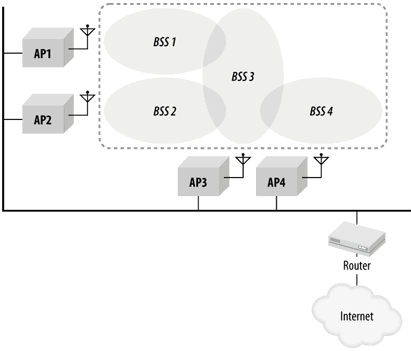Extended service areas
BSSs can create coverage in small offices and homes, but they cannot provide network coverage to larger areas. 802.11 allows wireless networks of arbitrarily large size to be created by linking BSSs into an extended service set (ESS). An ESS is created by chaining BSSs together with a backbone network. All the access points in an ESS are given the same service set identifier (SSID), which serves as a network "name" for the users.
802.11 does not specify a particular backbone technology; it requires only that the backbone provide a specified set of services. In Figure below, the ESS is the union of the four BSSs (provided that all the access points are configured to be part of the same ESS). In real-world deployments, the degree of overlap between the BSSs would probably be much greater than the overlap in Figure below. In real life, you would want to offer continuous coverage within the extended service area; you wouldn't want to require that users walk through the area covered by BSS3 when en route from BSS1 to BSS2.

Stations within the same ESS may communicate with each other, even though these stations may be in different basic service areas and may even be moving between basic service areas. For stations in an ESS to communicate with each other, the wireless medium must act like a single layer 2 connection. Access points act as bridges, so direct communication between stations in an ESS requires that the backbone network also look like a layer 2 connection. First-generation access points required direct layer 2 connections through hubs or virtual LANs; newer products implement a variety of tunneling technologies to emulate the layer 2 environment.
802.11 supplies link-layer mobility within an ESS, but only if the backbone network appears to be a single link-layer domain. This important constraint on mobility is often a major factor in the way that wireless LANs are deployed, and one of the major ways that vendors differentiate their products.
Early access points required that the backbone network be a single hub or VLAN, but newer products can interface directly with the backbone. Many can support multiple VLANs simultaneously with 802.1Q tags, and some can even dynamically instantiate VLANs based on authentication information.
Extended service areas are the highest-level abstraction supported by 802.11 networks. Access points in an ESS operate in concert to allow the outside world to use the station's MAC address to talk to a station no matter what its location is within the ESS. In Figure above, the router uses the station's MAC address as the destination to deliver frames to a mobile station; only the access point with which that mobile station is associated delivers the frame. The router remains ignorant of the location of the mobile station and relies on the access points to deliver the frame.
In this tutorial:
- 802.11 Networks
- IEEE 802 Network Technology Family Tree
- Nomenclature and Design
- Types of Networks
- Independent networks
- Infrastructure networks
- Extended service areas
- Multi-BSS environments: "virtual APs"
- Robust security networks (RSNs)
- The Distribution System, Revisited
- Interaccess point communication as part of the distribution system
- Wireless bridges and the distribution system
- Network Boundaries
- 802.11 Network Operations
- Network Services
- Station services
- Distribution system services
- Confidentiality and access control
- Spectrum management services
- Mobility Support
- Designing Networks for Mobility
